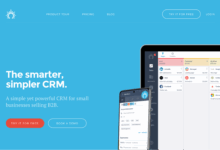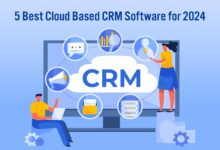CRM with AI Chatbot Integration: Enhanced Customer Engagement
CRM with AI Chatbot Integration represents a significant advancement in customer relationship management. This powerful combination leverages artificial intelligence to automate tasks, personalize interactions, and ultimately improve customer satisfaction and business outcomes. We will explore the core functionalities, implementation strategies, and the transformative impact this integration has on both customer experience and overall business efficiency.
From enhancing customer service through instant support to streamlining lead generation and sales processes, AI chatbots embedded within CRM systems offer a multitude of benefits. This exploration will delve into the practical applications, addressing potential challenges and outlining best practices for a successful integration. We’ll also examine the future trajectory of this technology and its evolving role in shaping customer interactions.
Defining CRM with AI Chatbot Integration
A Customer Relationship Management (CRM) system is a software solution designed to manage and analyze customer interactions and data throughout the customer lifecycle. It helps businesses understand customer needs, improve customer service, and ultimately increase sales and profitability. Integrating an AI chatbot into a CRM significantly enhances its capabilities, creating a more efficient and effective system.
Integrating an AI chatbot into a CRM system combines the organizational power of a CRM with the responsiveness and automation of artificial intelligence. This integration allows businesses to leverage AI’s capabilities to streamline communication, personalize customer experiences, and gain valuable insights from customer interactions. The result is a more efficient, cost-effective, and customer-centric approach to managing customer relationships.
Core Functionality of a CRM System
CRM systems typically provide a centralized repository for all customer-related data, including contact information, purchase history, communication logs, and support tickets. Core functionalities often encompass contact management, sales force automation, marketing automation, customer service support, and reporting and analytics. These features work together to provide a holistic view of the customer, enabling businesses to tailor their interactions and offerings accordingly. For example, a sales team can access a customer’s complete history to personalize their sales pitch, while the customer service team can quickly access past interactions to resolve issues efficiently.
Benefits of Integrating an AI Chatbot into a CRM
The integration of an AI chatbot offers several significant advantages. Firstly, it improves customer service responsiveness by providing immediate support 24/7, reducing wait times and increasing customer satisfaction. Secondly, it automates repetitive tasks, freeing up human agents to focus on more complex issues. This automation leads to increased efficiency and cost savings. Thirdly, AI chatbots can gather valuable customer data through interactions, providing insights into customer preferences, pain points, and potential areas for improvement. This data can be used to personalize marketing campaigns, enhance product development, and improve overall customer experience.
Examples of AI Chatbot Capabilities within a CRM Environment
AI chatbots within a CRM can perform a wide range of functions. They can answer frequently asked questions about products or services, guide customers through the purchasing process, schedule appointments, track orders, and provide personalized recommendations. More advanced chatbots can understand natural language, interpret customer sentiment, and escalate complex issues to human agents seamlessly. For instance, a chatbot could identify a frustrated customer based on their language and automatically route their inquiry to a senior agent for immediate attention. Another example is a chatbot proactively offering support based on identified customer behavior, such as a customer browsing a specific product category repeatedly without making a purchase.
Comparison of CRM Systems with and without AI Chatbot Integration
| Feature | CRM without AI Chatbot | CRM with AI Chatbot | Benefits of AI Integration |
|---|---|---|---|
| Customer Support | Relies primarily on human agents, potentially leading to longer wait times and inconsistent service. | Provides 24/7 instant support through AI chatbot, supplemented by human agents for complex issues. | Improved response times, increased customer satisfaction, reduced workload for human agents. |
| Lead Generation & Qualification | Manual lead identification and qualification processes. | Automated lead capture and qualification through chatbot interactions, identifying high-potential leads. | Increased efficiency in lead generation, improved lead quality, reduced time spent on manual tasks. |
| Sales Process | Relies on manual follow-up and communication. | Automates follow-up tasks, provides personalized recommendations, and guides customers through the sales funnel. | Improved sales conversion rates, enhanced customer experience, increased sales efficiency. |
| Data Analysis | Requires manual data analysis and reporting. | Collects and analyzes customer interaction data from chatbot conversations, providing valuable insights. | Data-driven decision making, improved understanding of customer behavior, enhanced personalization. |
AI Chatbot Features and Functionality within CRM
Integrating AI chatbots into a CRM system significantly enhances customer interactions and streamlines business processes. These intelligent assistants provide automated support, personalized experiences, and valuable data insights, ultimately boosting efficiency and customer satisfaction. The following sections detail key features and functionalities.
AI Chatbots Enhancing Customer Service
AI chatbots revolutionize customer service by offering immediate, 24/7 support. They handle routine inquiries, freeing up human agents to focus on complex issues. This instant response time improves customer satisfaction and reduces wait times. Furthermore, chatbots can be programmed to understand natural language, allowing for more natural and engaging conversations. They can also access and utilize customer data stored within the CRM, providing personalized service based on past interactions and preferences. For example, a chatbot could greet a returning customer by name and proactively offer assistance based on their previous purchase history.
AI Chatbots for Lead Generation and Qualification
AI-powered chatbots are highly effective in lead generation and qualification. They can engage website visitors in real-time, collecting valuable information through interactive conversations. By asking targeted questions and qualifying prospects based on pre-defined criteria, chatbots can identify high-potential leads and automatically route them to the appropriate sales representative. This automated process significantly improves lead conversion rates and reduces the time spent on manual lead qualification. For instance, a chatbot could pre-qualify leads by asking about their budget, needs, and timeline, ensuring sales teams focus on the most promising prospects.
AI Chatbots Automating Sales Processes
AI chatbots streamline various aspects of the sales process. They can schedule appointments, send follow-up emails, and provide product information, freeing up sales representatives to concentrate on closing deals and building relationships. Chatbots can also personalize the customer journey by providing tailored recommendations and offers based on individual preferences and past interactions. This level of automation improves sales efficiency and enhances the overall customer experience. For example, a chatbot can send automated email reminders about upcoming appointments or provide personalized product recommendations based on a customer’s browsing history.
Customer Journey Flowchart with AI Chatbot
The following describes a flowchart illustrating the customer journey within a CRM system utilizing an AI chatbot:
The flowchart begins with a customer accessing the company website or app. The AI chatbot greets the customer and assesses their needs. If the customer’s inquiry is simple (e.g., checking order status, finding product information), the chatbot directly addresses the request, providing the necessary information or completing the task. If the inquiry is more complex or requires human intervention, the chatbot gathers relevant information from the customer (e.g., name, contact details, issue description) and transfers the interaction to a human agent within the CRM system. The agent, having access to the complete interaction history provided by the chatbot, can seamlessly continue the conversation and resolve the issue. Finally, the system records the entire interaction, providing valuable data for analysis and process improvement. The visual representation would show boxes for each step connected by arrows indicating the flow, with decision points represented by diamonds showing the chatbot’s assessment of the customer’s needs. The final box would show the resolution and data recording.
Implementation and Integration Challenges
Integrating an AI chatbot into an existing CRM system presents several hurdles that need careful consideration. Successful implementation requires a strategic approach encompassing technical, operational, and data-related aspects. Overlooking these challenges can lead to integration failures, impacting customer experience and overall ROI.
Potential Integration Challenges
Data migration and synchronization between the CRM and the chatbot platform can be complex. Inconsistent data formats, incomplete data fields, and the need for data cleansing and transformation often present significant obstacles. For instance, transferring customer interaction history from a legacy CRM to a new chatbot platform may require extensive data mapping and validation to ensure accuracy and consistency. Furthermore, maintaining real-time synchronization between the two systems is crucial for providing customers with up-to-date information and a seamless experience. Differences in data structures and schemas between the CRM and the chatbot platform often necessitate custom integration solutions.
Best Practices for Successful Implementation
A phased approach to implementation minimizes disruption and allows for iterative improvements. Starting with a pilot project focusing on a specific use case, such as lead qualification or customer support, allows for testing and refinement before a full-scale deployment. Thorough planning and defining clear objectives are essential. This includes identifying specific business goals, defining key performance indicators (KPIs), and establishing a clear timeline. Selecting the right AI chatbot platform that is compatible with the existing CRM system and scalable to meet future needs is crucial. Regular monitoring and evaluation of the chatbot’s performance are vital to identify areas for improvement and ensure it meets the defined KPIs. Continuous training and updates of the chatbot’s knowledge base are necessary to maintain accuracy and relevance.
Technical Considerations for Different CRM Platforms
Integrating AI chatbots with different CRM platforms requires a nuanced approach due to varying APIs and data structures. For example, Salesforce’s robust API offers various integration options, including REST APIs and custom integrations. However, integrating with older or less-developed CRM systems might require more custom development and potentially more complex data transformation processes. The choice of integration method—API-based integration, middleware, or custom development—depends on the specific CRM system, the chatbot platform’s capabilities, and the organization’s technical expertise. Security considerations, including data encryption and access control, are paramount to protect sensitive customer data.
Common Integration Issues and Their Solutions
Addressing common integration issues proactively is vital for a smooth implementation. Below is a table outlining some typical problems and their solutions:
| Issue | Solution |
|---|---|
| Data synchronization errors | Implement robust data validation and error handling mechanisms. Regularly reconcile data between the CRM and chatbot systems. |
| Slow response times | Optimize chatbot logic and database queries. Consider using caching mechanisms to reduce latency. |
| Inaccurate chatbot responses | Regularly review and update the chatbot’s knowledge base. Implement mechanisms for user feedback and continuous learning. |
| Security vulnerabilities | Implement strong authentication and authorization protocols. Regularly conduct security audits and penetration testing. |
| Lack of user adoption | Provide comprehensive training and support to users. Promote the chatbot’s benefits and address any concerns. |
Impact on Customer Experience and Business Outcomes
Integrating AI chatbots into a CRM system significantly impacts both customer experience and overall business outcomes. The readily available, 24/7 support and personalized interactions fostered by these chatbots lead to improved customer satisfaction and increased efficiency across various business processes. This ultimately translates to higher sales conversion rates and improved bottom-line results.
AI chatbot integration enhances various aspects of a business, resulting in a positive ripple effect across departments. The immediate benefits are felt by customers, who experience quicker resolution times and more personalized service, leading to improved satisfaction and loyalty. Internally, businesses see streamlined workflows, reduced operational costs, and increased sales through better lead nurturing and targeted marketing.
Improved Customer Satisfaction
AI chatbots provide instant support, addressing customer queries promptly and efficiently. This immediate response significantly reduces customer wait times, a key factor in determining satisfaction. Furthermore, the ability of AI chatbots to personalize interactions, using data from the CRM to tailor responses to individual customer needs and preferences, fosters a sense of value and strengthens the customer relationship. For example, a chatbot can greet a returning customer by name and offer personalized recommendations based on their past purchases, creating a more engaging and positive experience. This personalized approach fosters customer loyalty and encourages repeat business.
Increased Sales Conversion Rates
AI chatbots can significantly contribute to increased sales conversion rates by proactively engaging potential customers and guiding them through the sales funnel. By providing instant answers to frequently asked questions, they remove common friction points in the buying process. They can also qualify leads more effectively, identifying high-potential customers and routing them to the appropriate sales representatives. For instance, a chatbot can collect information about a prospect’s needs and budget, pre-qualifying them before transferring them to a sales representative, saving valuable sales team time and improving conversion rates. Furthermore, AI chatbots can be programmed to offer targeted promotions and discounts based on customer behavior, further incentivizing purchases.
Improved Operational Efficiency
AI chatbots automate many routine tasks, freeing up human agents to focus on more complex issues and high-value interactions. This automation reduces the workload on customer service teams, leading to increased efficiency and reduced operational costs. For example, chatbots can handle simple requests such as order tracking, password resets, and basic product information, allowing human agents to concentrate on resolving more complex problems and building stronger relationships with customers. This automation also extends to internal processes, with chatbots assisting with tasks such as scheduling appointments, managing employee requests, and providing access to internal documentation. The resulting time savings and reduced human error contribute significantly to improved operational efficiency.
Key Performance Indicators (KPIs)
Tracking the success of AI chatbot integration requires monitoring specific KPIs. These metrics provide valuable insights into the effectiveness of the system and help identify areas for improvement.
- Customer Satisfaction (CSAT) Score: Measures customer satisfaction levels after interacting with the chatbot.
- Net Promoter Score (NPS): Gauges customer loyalty and willingness to recommend the business.
- Average Handling Time (AHT): Tracks the average time taken to resolve customer issues.
- First Contact Resolution (FCR) Rate: Measures the percentage of customer issues resolved on the first contact.
- Chatbot Resolution Rate: Indicates the percentage of customer queries resolved by the chatbot without human intervention.
- Lead Conversion Rate: Tracks the percentage of leads converted into customers through chatbot interactions.
- Cost Savings: Quantifies the reduction in operational costs due to chatbot automation.
Future Trends and Developments
The integration of AI chatbots within CRM systems is rapidly evolving, promising a future where customer interactions are more efficient, personalized, and insightful. This section explores the anticipated advancements in AI-powered CRM, focusing on the transformative role of emerging technologies and their impact on business strategies.
The evolving role of AI in CRM is shifting from basic automation to sophisticated predictive analytics and personalized customer journeys. AI is no longer just a tool for handling routine tasks; it’s becoming a strategic partner in understanding customer behavior, anticipating needs, and proactively addressing potential issues. This transformation is driven by continuous improvements in machine learning algorithms and the increasing availability of vast amounts of customer data.
Advancements in AI Chatbot Integration
Future advancements in AI chatbot integration will center around enhanced natural language processing (NLP), improved sentiment analysis, and the seamless integration of AI across various CRM functionalities. We can expect to see chatbots that understand nuanced language, context, and even emotions, leading to more human-like interactions. This will enable chatbots to handle complex customer queries, resolve issues autonomously, and personalize interactions at a much deeper level. For example, imagine a chatbot that not only understands the customer’s request for a refund but also detects frustration in their tone and proactively offers additional support to alleviate their negative experience. Furthermore, the integration of AI-powered predictive analytics will allow chatbots to anticipate customer needs and offer proactive solutions, leading to improved customer satisfaction and loyalty.
Impact of Emerging Technologies
Advancements in natural language processing (NLP) are poised to significantly enhance the capabilities of AI chatbots within CRM. More sophisticated NLP models will allow chatbots to understand and respond to complex queries, interpret colloquialisms and slang, and even detect sarcasm or subtle cues in customer communications. This will lead to more natural and engaging interactions, making the chatbot experience feel less robotic and more human. Furthermore, the integration of technologies like computer vision and voice recognition will expand the ways in which customers can interact with the chatbot, enabling more intuitive and accessible communication channels. For instance, a customer might be able to submit a claim by simply taking a picture of a damaged product using their mobile device, with the chatbot automatically processing the image and initiating the claim process.
Future Application Scenario
Imagine a future where a customer experiencing technical difficulties with a complex software application can interact with an AI-powered chatbot directly within the application itself. This chatbot, leveraging advanced NLP and contextual awareness, can understand the specific problem the customer is facing, guide them through troubleshooting steps, and even proactively identify and resolve underlying issues before the customer even notices them. If the problem persists, the chatbot can seamlessly escalate the issue to a human support agent, providing them with a complete history of the interaction and the customer’s context, ensuring a swift and efficient resolution. This proactive, contextualized support, facilitated by an intelligent chatbot, represents a significant leap forward in customer service efficiency and satisfaction. Such a system could significantly reduce resolution times, improve customer satisfaction scores, and free up human agents to focus on more complex issues.
Security and Privacy Considerations
Integrating AI chatbots into CRM systems offers significant advantages, but it also introduces new security and privacy challenges. The sensitive nature of customer data handled within a CRM necessitates a robust security framework to protect against potential breaches and ensure compliance with regulations like GDPR and CCPA. Failing to address these concerns can lead to reputational damage, financial penalties, and loss of customer trust.
AI chatbot integration expands the attack surface of a CRM system. Malicious actors could exploit vulnerabilities in the chatbot’s code or its integration with the CRM to gain unauthorized access to sensitive data. Furthermore, the chatbot itself could become a target for manipulation, potentially leading to data leakage or fraudulent activities. Data privacy is paramount, requiring careful consideration of data storage, processing, and transmission methods to comply with relevant regulations. Ethical considerations are also crucial, ensuring the chatbot operates transparently and respects user privacy rights.
Potential Security Risks Associated with AI Chatbot Integration
AI chatbot integration introduces several security risks. These include unauthorized access to customer data through vulnerabilities in the chatbot’s code or its interface with the CRM; data breaches resulting from compromised chatbot infrastructure; malicious use of the chatbot to obtain sensitive information through social engineering techniques; and the potential for AI bias to lead to discriminatory outcomes, violating privacy rights. Robust security measures are crucial to mitigate these risks.
Data Privacy and Compliance Measures
Maintaining data privacy requires a multi-faceted approach. This includes implementing strong access controls to limit access to sensitive customer data; utilizing encryption both in transit and at rest to protect data from unauthorized access; anonymizing or pseudonymizing data wherever possible to reduce the risk of identification; implementing robust logging and monitoring systems to detect and respond to security incidents; and regularly conducting security audits and penetration testing to identify and address vulnerabilities. Compliance with regulations like GDPR and CCPA is achieved through adherence to data minimization principles, obtaining explicit consent for data processing, and providing users with control over their data.
Ethical Considerations in Designing and Deploying AI Chatbots
Ethical considerations are central to responsible AI chatbot deployment. Transparency is crucial; users should be informed about the use of AI and how their data is being processed. Fairness necessitates designing chatbots that avoid bias and discrimination. Accountability means establishing clear lines of responsibility for the chatbot’s actions and outcomes. Privacy must be respected, ensuring user data is protected and not misused. Finally, security measures must be implemented to prevent malicious use or manipulation of the chatbot.
Best Practices for Securing Sensitive Customer Data
Several best practices are vital for securing sensitive customer data within a CRM system using an AI chatbot. These include: regularly updating the chatbot’s software and underlying infrastructure to patch known vulnerabilities; implementing multi-factor authentication (MFA) to protect access to the CRM and chatbot; using intrusion detection and prevention systems to monitor for malicious activity; regularly backing up data to prevent data loss in the event of a security breach; and providing comprehensive employee training on security best practices. Employing robust data loss prevention (DLP) tools helps monitor and control the flow of sensitive information. Regular security assessments and penetration testing are crucial for proactively identifying and mitigating vulnerabilities.
Wrap-Up
In conclusion, the integration of AI chatbots into CRM systems marks a pivotal shift in how businesses interact with their customers. By automating processes, personalizing interactions, and providing immediate support, AI-powered CRMs are driving significant improvements in customer satisfaction, sales conversion rates, and operational efficiency. While challenges exist in implementation, the long-term benefits clearly outweigh the initial hurdles, promising a future of enhanced customer engagement and streamlined business operations.





